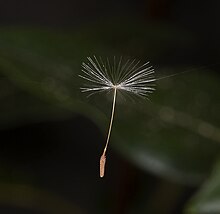This article may require copy editing for grammar, style, cohesion, tone, or spelling. (April 2024) |

Biological dispersal refers to both the movement of individuals (animals, plants, fungi, bacteria, etc.) from their birth site to their breeding site ('natal dispersal') and the movement from one breeding site to another ('breeding dispersal'). Dispersal is also used to describe the movement of propagules such as seeds and spores. Technically, dispersal is defined as any movement that has the potential to lead to gene flow.[1] The act of dispersal involves three phases: departure, transfer, and settlement. There are different fitness costs and benefits associated with each of these phases.[2] Through simply moving from one habitat patch to another, the dispersal of an individual has consequences not only for individual fitness, but also for population dynamics, population genetics, and species distribution.[3][4][5] Understanding dispersal and the consequences, both for evolutionary strategies at a species level and for processes at an ecosystem level, requires understanding on the type of dispersal, the dispersal range of a given species, and the dispersal mechanisms involved. Biological dispersal can be correlated to population density. The range of variations of a species' location determines the expansion range.[6]
Biological dispersal may be contrasted with geodispersal, which is the mixing of previously isolated populations (or whole biotas) following the erosion of geographic barriers to dispersal or gene flow.[7][8][9]
Dispersal can be distinguished from animal migration (typically round-trip seasonal movement), although within population genetics, the terms 'migration' and 'dispersal' are often used interchangeably.
Furthermore, biological dispersal is impacted and limited by different environmental and individual conditions.[10] This leads to a wide range of consequences on the organisms present in the environment and their ability to adapt their dispersal methods to that environment.
- ^ Ronce O (2007). "How does it feel to be like a rolling stone? Ten questions about dispersal evolution". Annual Review of Ecology, Evolution, and Systematics. 38: 231–253. doi:10.1146/annurev.ecolsys.38.091206.095611.
- ^ Bonte D, Van Dyck H, Bullock JM, Coulon A, Delgado M, Gibbs M, Lehouck V, Matthysen E, Mustin K, Saastamoinen M, Schtickzelle N, Stevens VM, Vandewoestijne S, Baguette M, Barton K, Benton TG, Chaput-Bardy A, Clobert J, Dytham C, Hovestadt T, Meier CM, Palmer SC, Turlure C, Travis JM (May 2012). "Costs of dispersal". Biological Reviews of the Cambridge Philosophical Society. 87 (2): 290–312. doi:10.1111/j.1469-185X.2011.00201.x. PMID 21929715. S2CID 30660996.
- ^ Dunning JB, Stewart DJ, Danielson BJ, Noon BR, Root TL, Lamberson RH, Stevens EE (1995). "Spatially explicit population models: current forms and future uses" (PDF). Ecological Applications. 5 (1): 3–11. Bibcode:1995EcoAp...5....3D. doi:10.2307/1942045. JSTOR 1942045.
- ^ Hanski I, Gilpin ME, eds. (1997). Metapopulation biology : ecology, genetics and evolution. San Diego: Academic Press. ISBN 978-0-12-323446-9.
- ^ Hanski I (1999). Metapopulation Ecology. Oxford: Oxford University Press. ISBN 978-0-19-854065-6.
- ^ Smayda, Theodore J. (2007-08-01). "Reflections on the ballast water dispersal—harmful algal bloom paradigm". Harmful Algae. 6 (4): 601–622. Bibcode:2007HAlga...6..601S. doi:10.1016/j.hal.2007.02.003. ISSN 1568-9883.
- ^ Lieberman BS (2005). "Geobiology and paleobiogeography: tracking the coevolution of the Earth and its biota". Palaeogeography, Palaeoclimatology, Palaeoecology. 219 (1–2): 23–33. Bibcode:2005PPP...219...23L. doi:10.1016/j.palaeo.2004.10.012.
- ^ Lieberman BS (2005). "Geobiology and paleobiogeography: Tracking the coevolution of the Earth and its biota". Palaeogeography, Palaeoclimatology, Palaeoecology. 219 (1–2): 23–33. Bibcode:2005PPP...219...23L. doi:10.1016/j.palaeo.2004.10.012.
- ^ Albert JS, Reis RE (2011). Historical Biogeography of Neotropical Freshwater Fishes. University of California Press. p. 308. ISBN 978-0-520-26868-5.
- ^ Wu, Nicholas C.; Seebacher, Frank (2022-02-03). "Physiology can predict animal activity, exploration, and dispersal". Communications Biology. 5 (1): 109. doi:10.1038/s42003-022-03055-y. ISSN 2399-3642. PMC 8814174. PMID 35115649.